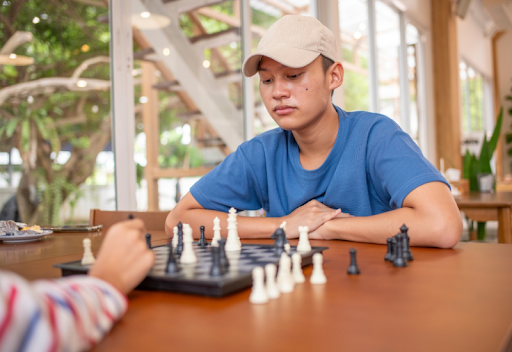Imagine playing a game of soccer with a ball that’s not quite round or using a basketball that’s the size of a tennis ball. It would be a bit of a mess, right? Chess tournaments face a similar dilemma without standardized chess sets. Whether you’re an aspiring grandmaster or a passionate hobbyist, understanding the specifics of the tournament chess board can make all the difference in your game. After all, consistency and precision matter when every move counts. Let’s dive into what makes a tournament-grade chess set the real deal!
Standard Tournament Chess Boards
Tournament chess boards aren’t just any boards pulled off a shelf—they are carefully designed with specific criteria to ensure fairness and consistency across competitions. These standards maintain a level playing field for all players, allowing the focus to remain on strategy rather than the board.
Description of Standard Square Size and Color Contrast
One of the key aspects of a tournament chess board is the size of its squares. According to official standards, each square should measure between 2 to 2.5 inches. This size is considered ideal as it comfortably fits the base of standard chess pieces, ensuring each piece occupies its space without crowding neighboring squares. A common size used in major competitions is the 2.25-inch square.
The board’s color contrast is also crucial. Typically, boards feature a light color, such as off-white or light beige, and a dark color, such as dark brown or black. The contrast should be high enough to ensure that both pieces and squares are distinguishable under various lighting conditions. Imagine trying to play on a board with squares too similar in shade—it could turn a strategic match into a visual guessing game.
Materials Commonly Used in Tournament Chess Board
The material of the tournament chess board is more than just about aesthetics. Durability, texture, and ease of transport are key factors. Standard tournament boards are usually made from materials such as vinyl, wood, or roll-up mats. Vinyl boards are common in many tournaments due to their affordability and portability. You can roll them up and take them to any event without worrying about damage.
For higher-level tournaments and championships, wooden boards are preferred. Materials like walnut, maple, and rosewood are commonly used, adding a classic and professional look to the competition. These boards are heavier and provide a more luxurious playing experience. However, they do require careful handling and maintenance compared to vinyl boards.
Having the right tournament chess board is essential for a seamless game experience, but mastering the board is only the beginning. At Caissa School of Chess, you’ll not only learn to navigate tournament-standard boards but also develop the strategic skills to dominate any match.
Whether you’re practicing on vinyl or wooden boards, the school’s world-class coaching will ensure you’re prepared for every scenario.
Standard Chess Pieces Used in Tournament Chess Board
When it comes to tournament play, the pieces themselves must meet precise standards to ensure consistency, fairness, and ease of play.
Specifications for Weight and Size of Chess Pieces
Tournament chess board pieces are designed to have a good weight to them—light enough to move effortlessly, yet heavy enough to remain stable on the board. This is especially important in time-sensitive matches where rapid movements can easily knock over lighter pieces. The ideal weight for a standard set is around 2 to 4 pounds in total, with the king being the heaviest.
Speaking of kings, let’s talk about size. The king’s height is typically around 3.75 inches, with a base that fits comfortably on a 2.25-inch square. The proportionality between the king and the board’s squares ensures that players can assess the positions at a glance, reducing the risk of mistakes due to visual miscalculations.
Common Materials Used for Manufacturing Tournament Chess Pieces
Chess pieces used in tournaments are often made from plastic, wood, or a combination of composite materials. Plastic pieces are favored in scholastic and local tournaments due to their affordability and durability. For higher-level tournaments, wooden sets are a staple. Woods like boxwood, rosewood, and ebony add an element of tradition and elegance to the game.
The iconic Staunton design is required in all official tournaments. Named after Howard Staunton, a British chess master, these pieces are recognizable by their distinct yet classic design, making them easy to differentiate during fast-paced games.
DGT Boards: Revolutionizing Tournament Chess Board
DGT (Digital Game Technology) boards are now the standard in top-level chess tournaments, revolutionizing how games are played, recorded, and analyzed. These digital chess boards automatically register every move made during a game, transmitting the data to external devices such as clocks, computers, and display screens. This real-time tracking significantly enhances both the player’s and viewer’s experience by ensuring the accuracy of move recording and enabling live broadcasts of games.
How DGT Boards Work in Tournaments
DGT boards have sensors embedded in the squares, and each chess piece has a unique electronic signature. As a piece is moved, the board detects the change and updates the system instantaneously. These boards are compatible with both traditional wooden pieces and digital interfaces, making them versatile for various formats, from local tournaments to world championships.
Advantages of DGT Boards in Tournament Play:
- Accurate Move Recording: DGT boards remove the need for manual notation, ensuring that every move is recorded accurately, which is especially important for post-game analysis and live commentary.
- Seamless Integration with Clocks: These boards connect directly to digital chess clocks, automating the timing process and eliminating delays between move registration and clock adjustments.
- Live Streaming: DGT boards enable live broadcasting of chess matches, allowing audiences from around the world to follow along in real time. This has significantly boosted the accessibility of high-level chess to a global audience.
Incorporating DGT chess tournament boards into your chess training can simulate the exact conditions used in professional tournaments, allowing you to train like a grandmaster. At Caissa School of Chess, students not only practice on DGT boards but also receive detailed, AI-powered feedback based on their performance, helping them prepare for top-level competition.
Digital Chess Sets
As technology has evolved, so too has the way we play chess, even in official settings. Digital chess sets have become more prevalent, especially in tournaments where precision and time management are critical.
Introduction to Digital Chess Sets in Tournament Settings
Digital chess sets integrate with electronic scoreboards and clocks, automatically recording moves and transmitting them in real-time. This innovation reduces the chance of human error in recording moves, ensuring accuracy throughout the game. It’s particularly useful in high-stakes matches where every move is scrutinized by analysts and audiences.
These sets are most often seen in high-level tournaments, where they can connect to display screens, allowing spectators to follow along with each move. They’ve become a popular tool in grandmaster events and online hybrid tournaments where real boards are combined with online play.
Advantages of Using Digital Chess Sets During Competitions
Digital sets come with several advantages:
- Enhanced Accuracy: By automatically recording moves, digital sets eliminate the need for players to manually note each move, allowing them to focus fully on their game.
- Time Efficiency: In rapid and blitz formats, speed is essential. Digital boards sync seamlessly with clocks, reducing delays in timing.
- Real-time Analysis: These sets can be connected to analysis software, making it easier for tournament organizers to review games instantly.
For serious players, using a digital chess set at home can simulate the experience of playing in a professional setting, offering a strategic edge.
As digital chess sets become the norm in high-level tournaments, they offer more than just the convenience of automatic move recording—they provide players with the precision and accuracy needed for top-tier competition. To fully leverage the potential of digital chess sets, Caissa School of Chess can help you integrate this cutting-edge technology into your training. With guidance from world-class coaches, you’ll gain firsthand experience in using digital boards, honing the skills you need to compete at the highest levels. Ready to play like a grandmaster? Join Caissa and master the future of tournament chess today!
Types of Clocks Used with Tournament Chess Set
Time control is a critical aspect of chess competitions. Whether it’s a nail-biting blitz game or a leisurely classical match, chess clocks ensure that both players are held to the same time standard.
Introduction to Analog and Digital Clocks
Traditionally, analog clocks were the norm in chess. These mechanical clocks feature a dual-face design with each player’s time displayed separately. When one player makes a move, they press a button that stops their clock and starts their opponent’s. Analog clocks, while nostalgic, are less common in modern tournaments due to their lack of precision in time increments.
Digital clocks have become the standard in most tournaments today. They offer greater accuracy and allow for time controls with increments (extra time added after each move). This is essential in formats like rapid and blitz chess, where every second counts. Digital clocks can display time more precisely, down to tenths of a second, which can make all the difference in a fast-paced game.
Requirements and Functionalities of Chess Clocks in Tournaments
For a chess clock to be used in tournaments, it must meet specific requirements:
- Dual-timer functionality: Both players should have independent timers that can be paused or started as needed.
- Increment support: Many competitions require clocks that support adding extra seconds per move, known as Fischer increments.
- Easy-to-read display: Players need to see the time clearly without needing to squint or pause the game. A bright, clear digital readout is preferred.
Chess clocks are as integral to the game as the pieces and board. Without them, chess would lose the competitive edge that keeps players on their toes.
Regulations Governing Tournament Chess Sets
When it comes to chess, the rules of the game extend beyond moves on the board. There are stringent regulations governing the equipment used, ensuring that no player has an advantage over another due to the set they use.
FIDE Regulations on Chess Boards and Pieces
The Fédération Internationale des Échecs (FIDE), the international chess federation, sets the standards for all equipment used in official tournaments. FIDE specifies the size, weight, and material requirements for boards and pieces, ensuring uniformity. For instance, the board should have a minimum size of 45 cm (17.7 inches) with squares of 5 to 6 cm, and the chess pieces must adhere to the Staunton pattern.
These regulations are designed to make sure that the pieces are clearly visible and easily distinguishable, which is particularly important for visually impaired players.
Adhering to Regional and National Chess Body Standards
While FIDE rules apply globally, regional and national chess federations, such as the United States Chess Federation (USCF), might have additional standards. These standards ensure that tournaments held in specific regions meet local preferences while aligning with global standards.
Understanding these rules is crucial for tournament organizers and players alike. A set that meets USCF standards, for example, may be required for national-level competitions, while FIDE-approved sets are mandatory for international play.
Customization and Branding of Chess Sets
While standardization is crucial, there’s still room for a touch of personalization in the world of tournament chess.
Permissible Customization Options for Players and Organizers
Customization of chess sets in tournaments is usually limited to branding opportunities and non-intrusive adjustments. For instance, many tournaments allow organizers to include their logo on the board or pieces as long as it doesn’t distract players. Board sponsors might use subtle logos on the corners of boards during large events, ensuring visibility without disrupting the focus of the game.
Players, too, may use custom bags or boxes for their sets, adding a personal flair to their chess tools without affecting gameplay. However, the core pieces and boards must remain standard-compliant.
Branding Opportunities on Chess Tournament Boards and Equipment
In larger events like the World Chess Championship, branding is a significant aspect. Organizers often collaborate with sponsors to design special edition boards that are compliant with FIDE standards. These boards can later become collector’s items, serving as memorabilia for fans and players alike.
Custom-branded boards can also be used for promotional purposes, helping sponsors reach a wider audience within the chess community. It’s a subtle yet effective way to combine passion for the game with marketing.
Future Developments in Chess Tournament Board Equipment
As with all things, technology and innovation continue to shape the future of chess equipment. Here’s what might be in store:
Technological Advancements in Chess Set Manufacturing
The next wave of chess set manufacturing is likely to focus on smart boards with enhanced digital capabilities. These smart boards can automatically record games, provide real-time analysis, and integrate with online streaming platforms. Imagine being able to broadcast a live game directly from a board to a global audience—this is already becoming a reality in some events.
Materials like carbon fiber could also be used to create more durable and lightweight boards, making transport easier for professional players who travel to multiple tournaments.
Trends Towards Sustainability and Environmentally Friendly Materials
Sustainability is increasingly becoming a priority across all industries, and chess is no exception. Manufacturers are exploring eco-friendly materials such as bamboo and recycled plastics for both boards and pieces. These options are not only better for the environment but also add a unique aesthetic to the game.
Using biodegradable packaging and sustainable wood sourcing practices ensures that chess, a timeless game, leaves a minimal environmental footprint.
Wrapping Up: Mastering the Art of the Chess Tournament Board
Chess is a game of precision, strategy, and tradition, and the equipment used is no less important than the skills of the players themselves. From the standardization of boards and pieces to embracing digital advancements, knowing the specifics of the chess tournament board can give players and organizers an edge in competitive play. As chess continues to evolve, so too does the equipment, blending tradition with modernity.
Looking to sharpen your skills before your next tournament? Try Caissa School of Chess for AI-driven coaching, real-time game analysis, and easy access to tournaments around the world. Whether you’re mastering classic moves or exploring new strategies, CircleChess can help take your game to the next level.
What do you think will be the next big innovation in tournament chess sets? Share your thoughts and join the conversation!





